Brazilian Tapioca Crepes are a popular street food with indigenous roots from my Northeast region in Brazil. You can prepare them quickly with tapioca flour, water or juice, and salt, making a cheap breakfast, vegan snack, or gluten-free lunch or dinner.
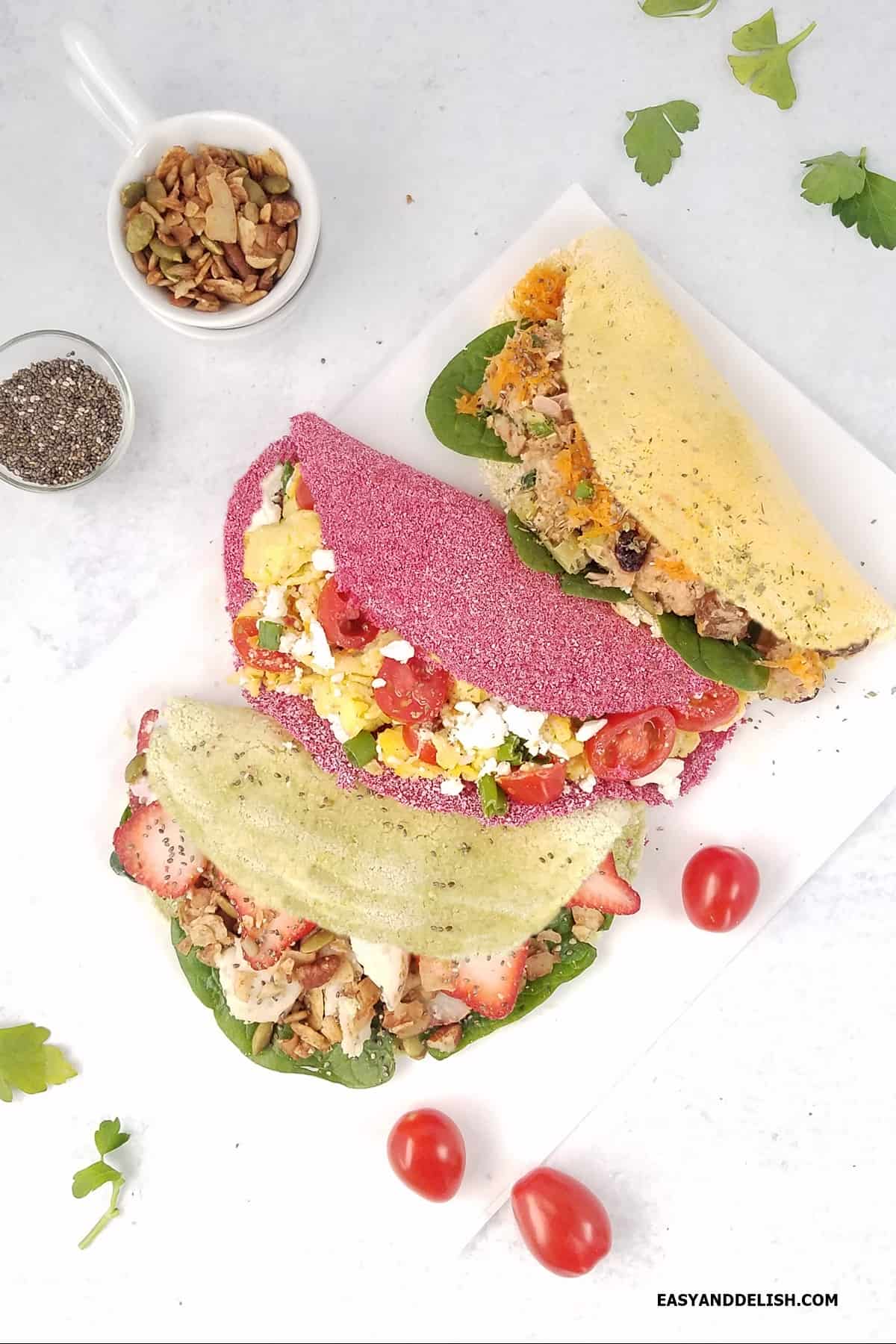
Table of Contents
How to Make Brazilian Tapioca
- Prepare the juice to color the tapioca crepes: In a blender, blend one of the vegetables (spinach, beets, or carrots) with water until smooth.
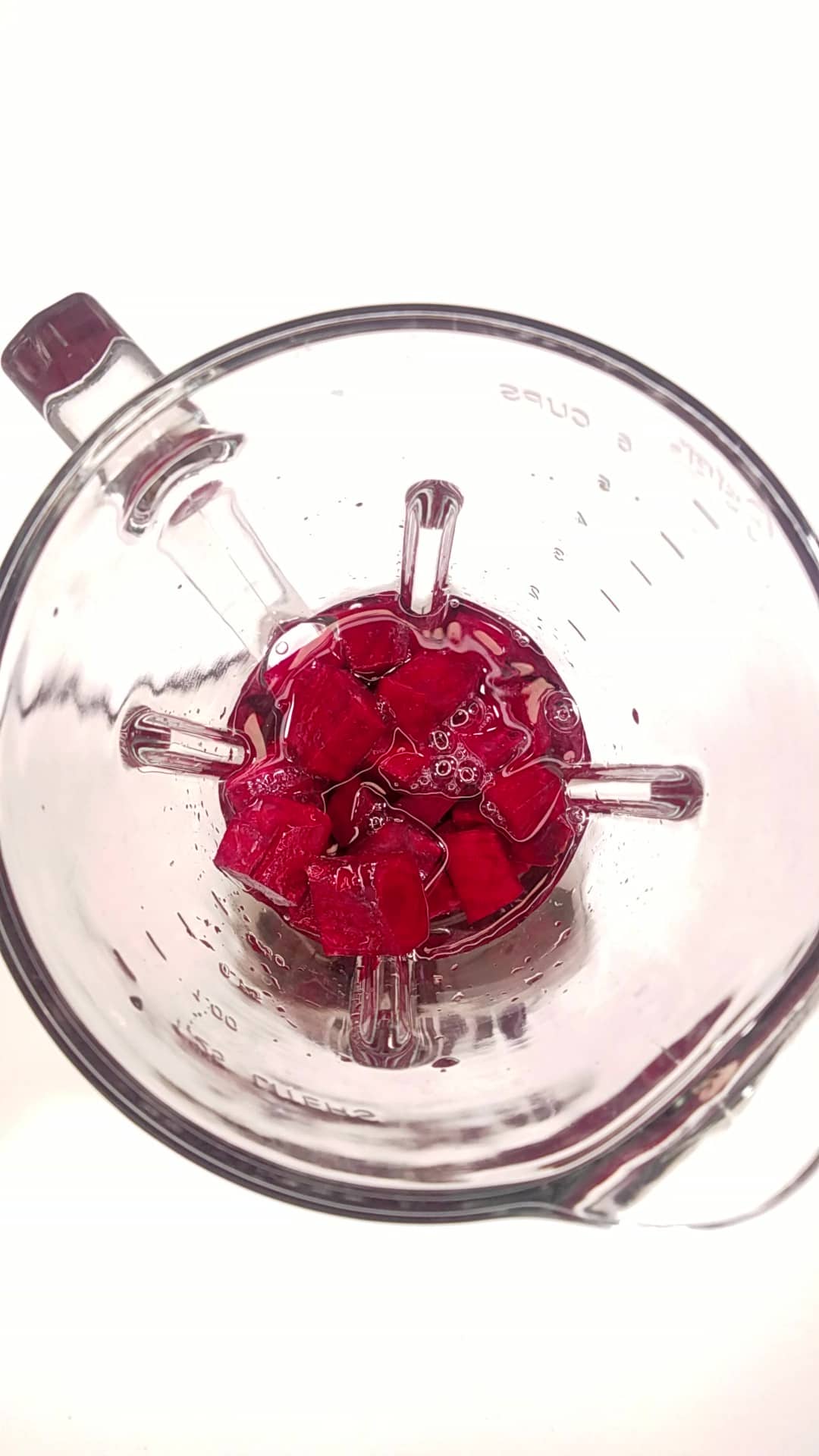
- Using a fine-mesh sieve, strain the liquid and discard the pulp (or use it to make something else). Reserve the strained juice. NOTE: If you prefer to prepare the most common type of tapioca which is white, simply use water instead of juice. The vegetable juices won't flavor the crepes. They only color the tapioca flour with natural food coloring.
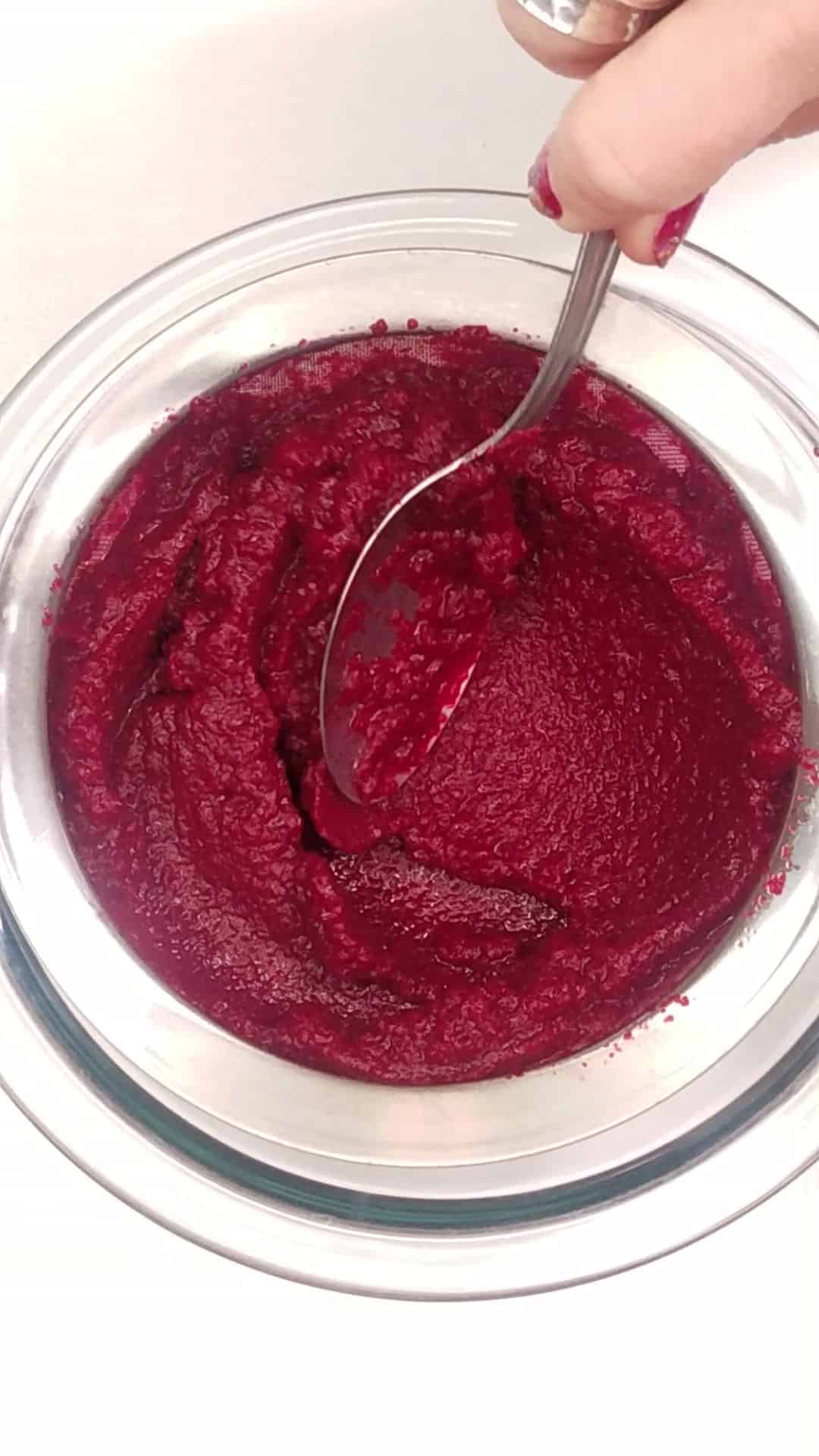
- Prepare the tapioca crepes: Add the tapioca flour to a medium bowl. Then, combine a pinch of salt and 3 tablespoons of the strained juice, mixing them well with your fingers until homogeneous and moistened but not to the point of forming a uniform liquid slurry. Place a spoonful of the tapioca mixture in one of your hands and press it tightly. If it forms a fairly moist yet well-set dough that can crumble when placed back into the bowl, the consistency is correct. TIP: However, if it gets too soft or liquid like a slurry, stir in a little bit of the tapioca flour. If too dry, combine just a little bit more of the juice.
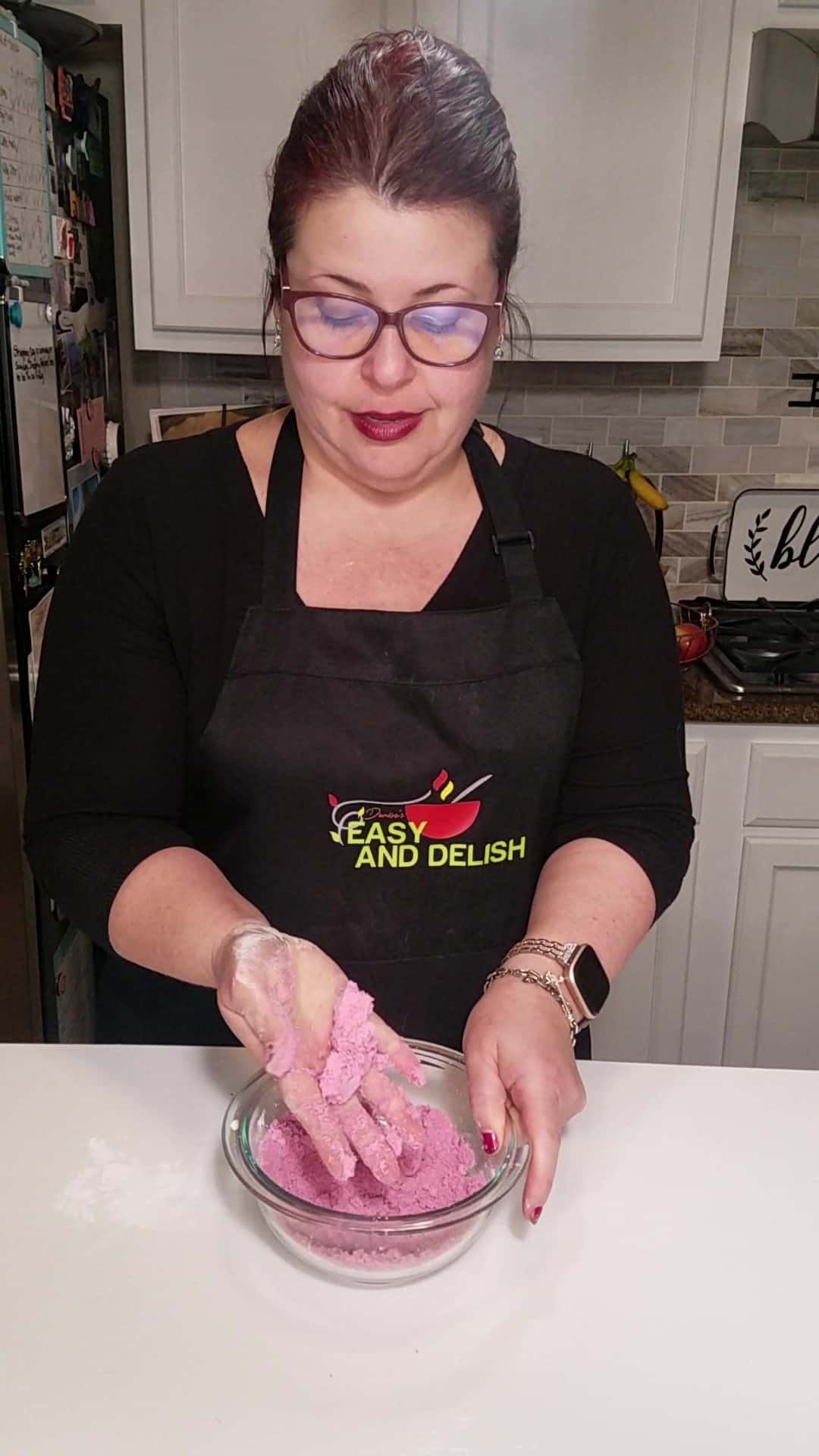
- Heat a small (5-½ inch diameter) non-stick skillet over medium-high heat for about 1-2 minutes, or until hot. Place the wet tapioca flour in a medium sieve. Use one hand to hold the sieve over the skillet and the other to press/rub the starch through the sieve into the skillet.
- Sieve and cook the Brazilian tapioca crepes: Sieve the starch in such a way that when it falls into the pan from the sieve it will form a uniform circle. Reduce the heat to medium.
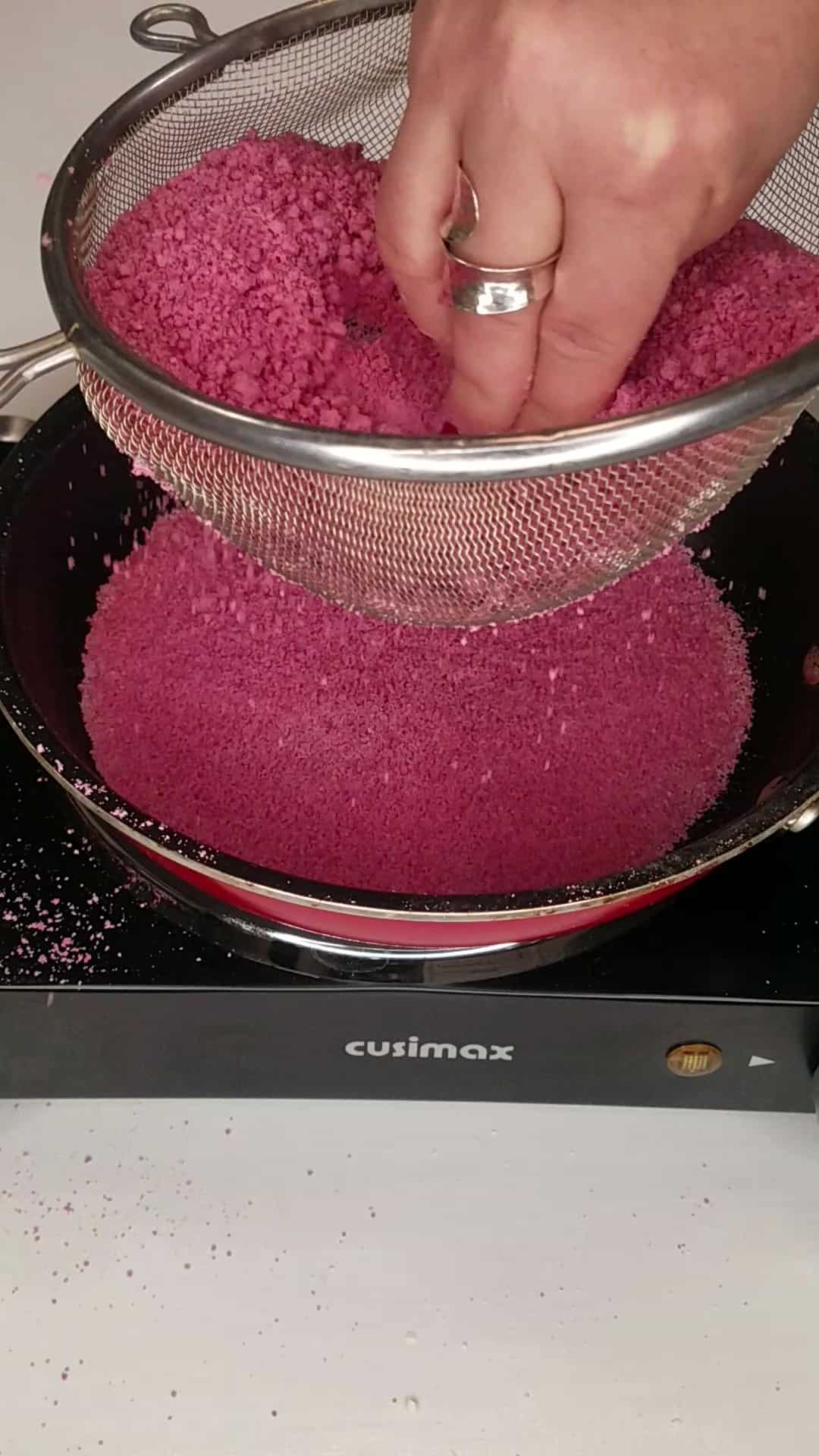
Let the heat bind and glue the grains so that the starch solidifies and forms a crepe/tortilla (pay close attention, because the crepe/tortilla will be ready in 15-30 seconds).
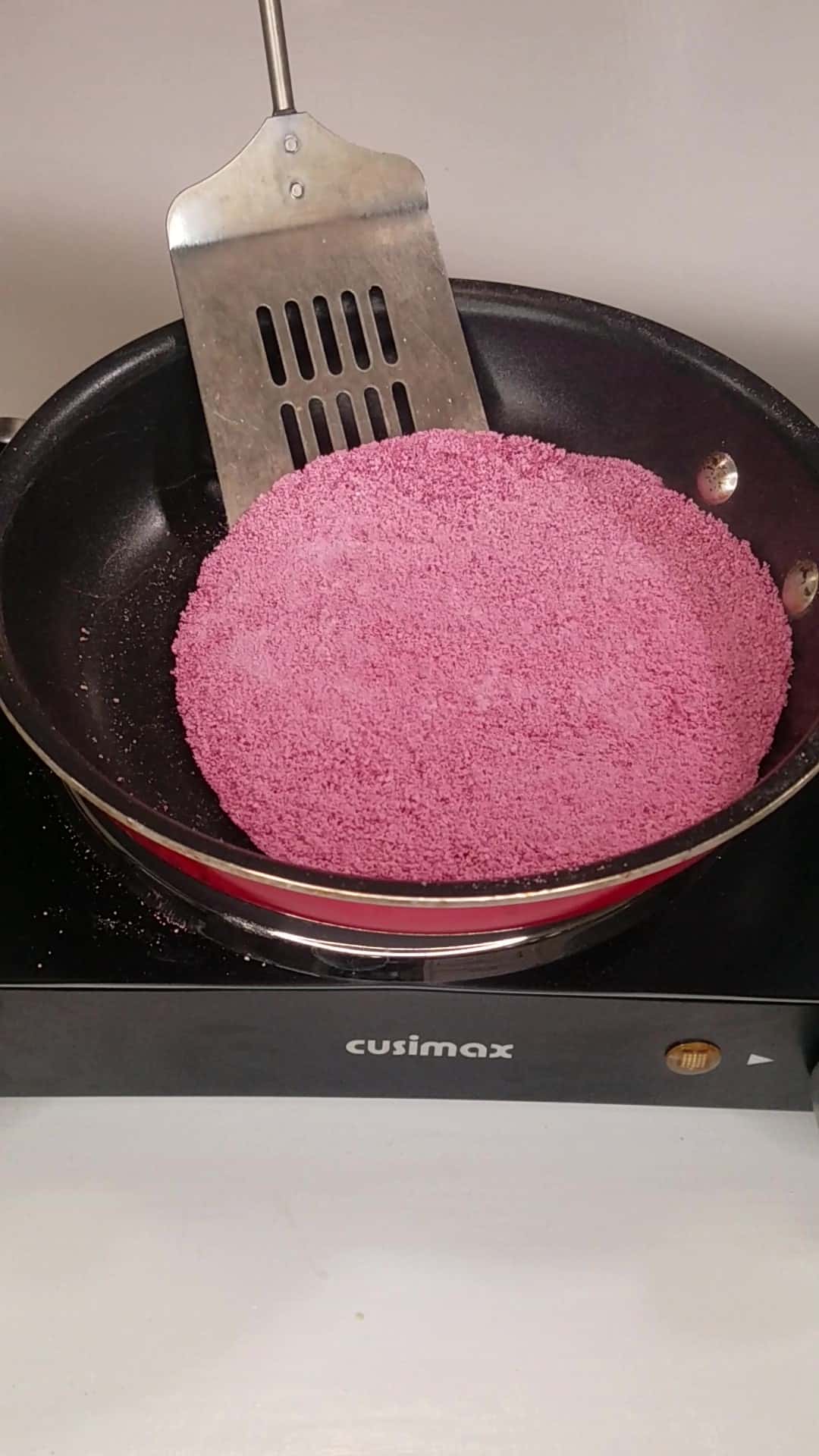
Make sure that the edges have as much starch as the center- that way, the edges will not be prone to breakage. Flip the tapioca over using a metal spatula with thin edges and cook very briefly on the other side, or simply slide the tapioca crepe onto a plate.
- Fill them: Place on a plate, spread butter on one of the sides of the tapioca crepe, and fill with any filling of your choice such as chicken or tuna salad (with less mayo), scrambled eggs, melted cheese, shredded meats, Nutella with sliced strawberries, or peanut butter with sliced bananas, etc. TIP: If the filling gets too wet, it will make the crepe break apart.
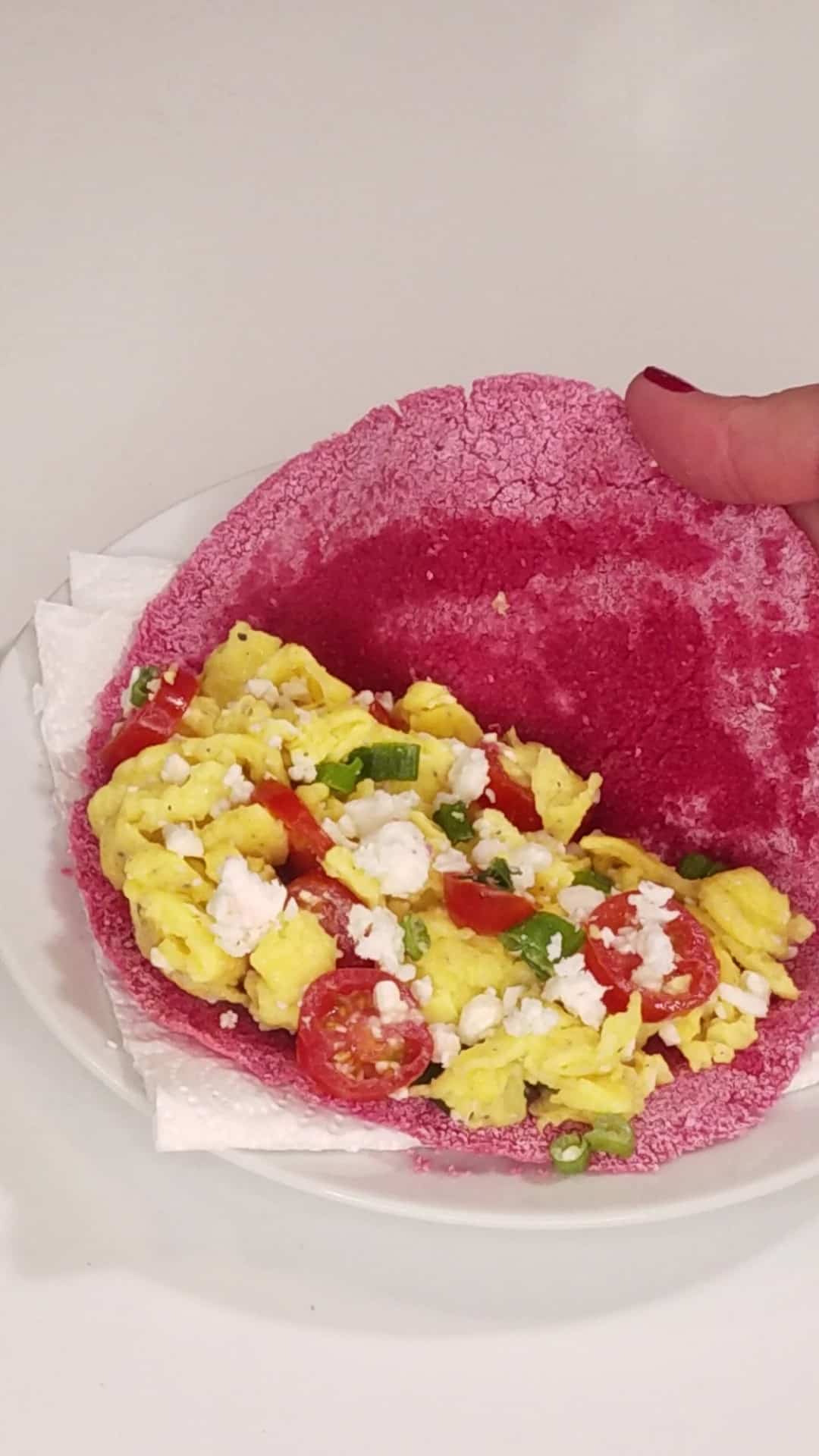
- If filling with shredded mozzarella cheese, place the tapioca crepe on a plate, spread butter on both sides, fill with shredded cheese, roll the tapioca crepes up (like an enchilada), or simply fold it like a taco, return to the skillet over medium heat, and let the cheese melt. Remove from heat and serve immediately.
NOTE: Between making one tapioca crepe and the next, please remove the skillet from heat and wipe both the bottom and sides of the skillet clean with a wad of paper towels (being careful to not burn yourself), so that the next tapioca won't be browned by the singed leftover grains of starch.
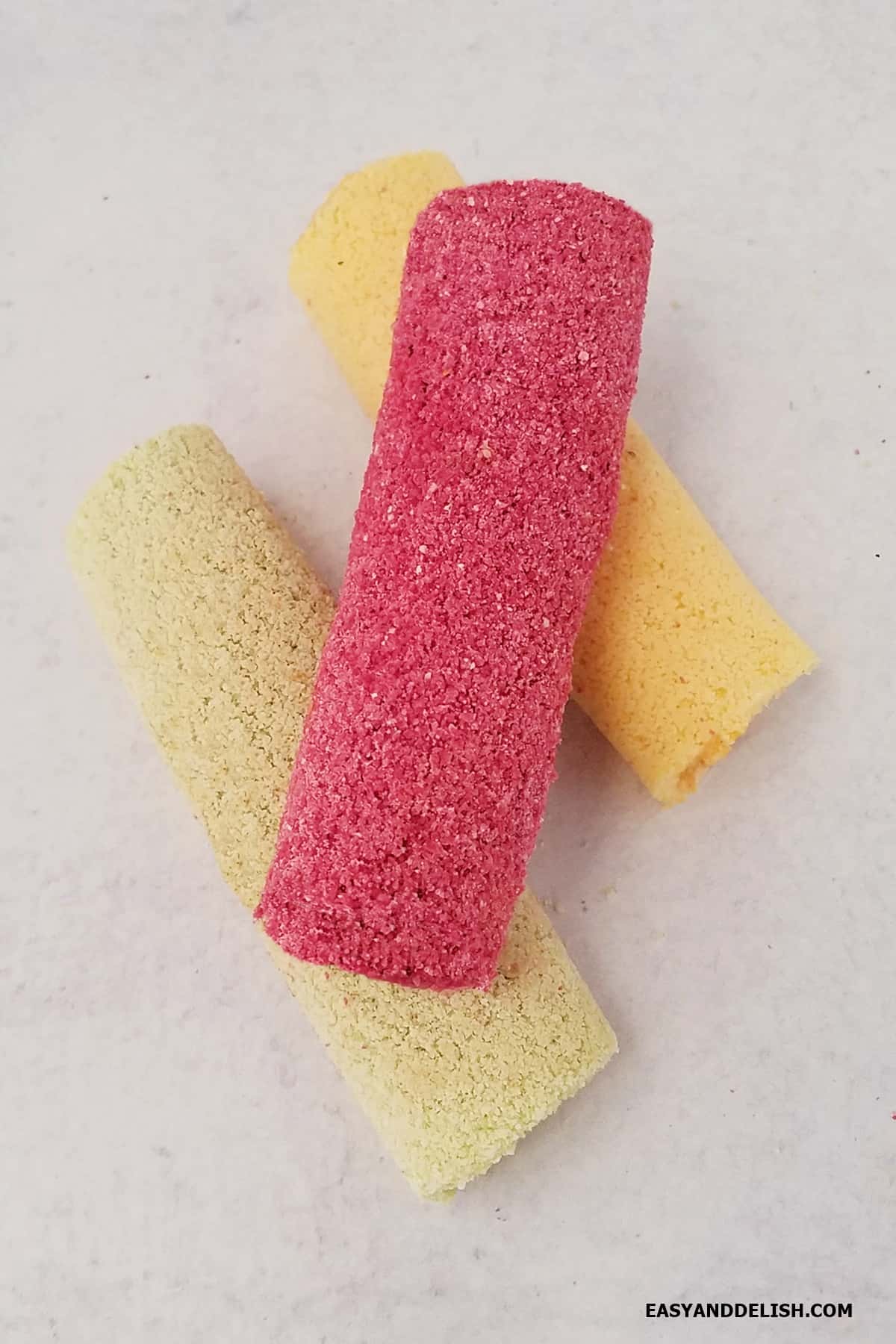
MEAL PREP AHEAD TIP: Store any leftover juice for later use in a Mason jar for up to 3-4 days in the fridge. Or, mix each juice with enough tapioca flour and store each in a separate airtight container in the fridge for up to 7 days though.
Watch me making colorful tapioca crepes with beet juice (pink tapioca crepes), carrot and turmeric juice (yellow tapioca crepes), and spinach juice (green tapioca crepes).
It's so good to know that I can use tapioca flour to make tapioca. I am Brazilian and find the sour tapioca is very hard. Thanks for teaching us how to make this using one that we can find anywhere in the US. Love your recipes!" -- Lucia
Ingredients and Substitutions
To make colorful tapioca crepes, you'll need:
Vegetable Juice
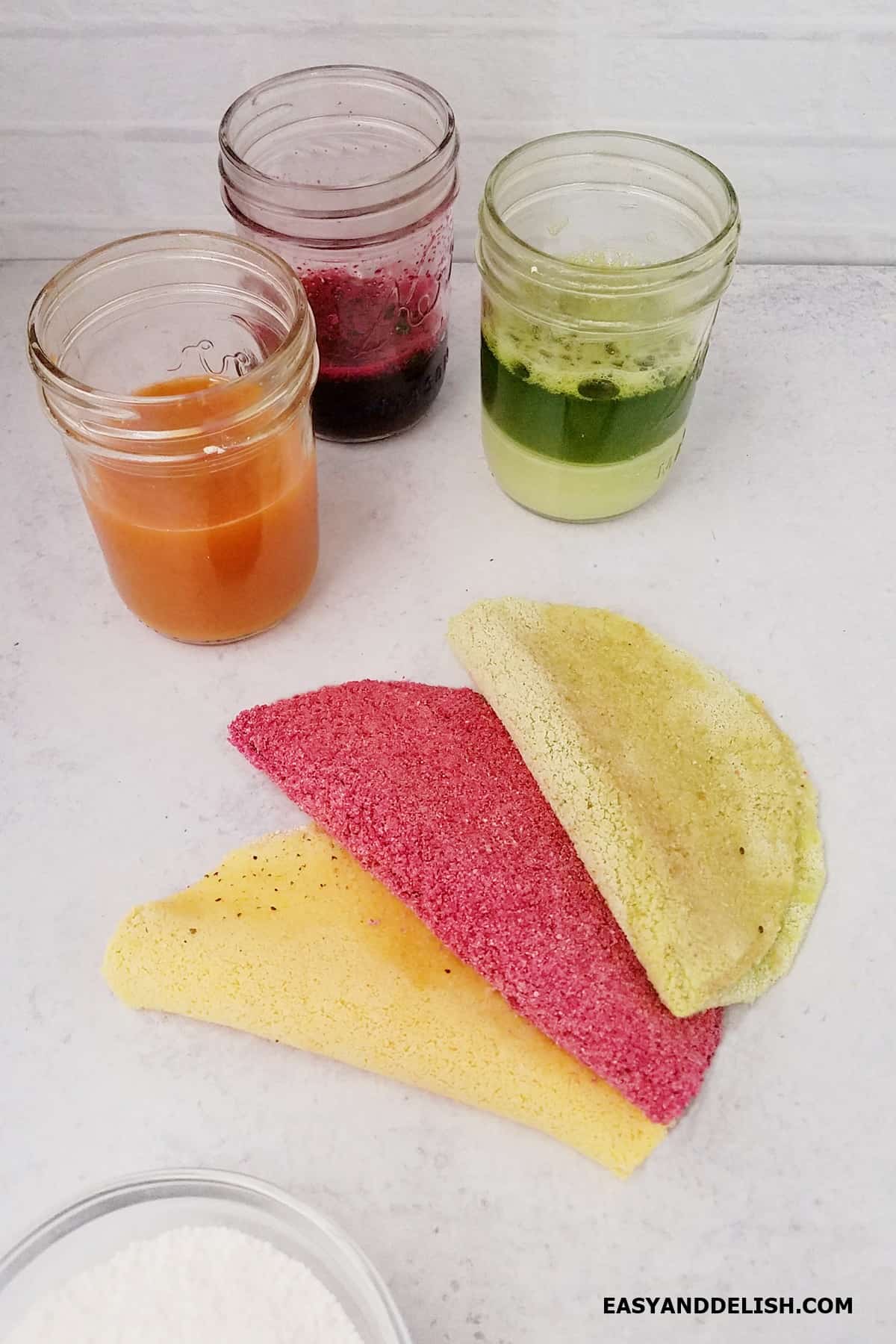
- ¾ cup water (if you prefer to make your tapioca crepe white, use water only and skip making any vegetable juice).
- 1 cup baby spinach, fully packed -- chopped kale (for the GREEN crepes). Or, peeled chopped beets (pink tapioca crepes) or baby carrots (yellow crepes). For making brown crepes, use prepared black coffee (liquid), unsweetened.
- A pinch of ground turmeric, optional (only if using carrots)
Tapioca Crepes
- ½ cup tapioca flour (If using pre-hydrated tapioca flour, you'll need less juice, about 1 to 1 ½ tablespoons, to color your crepes. Alternatively, you can swap tapioca flour with sour starch, or polvilho azedo, a by-product of the cassava root)
- A pinch of table salt
Fillings for Brazilian Tapioca Crepes
The possibilities are endless. You can fill your tapioca crepes with pretty much any savory or sweet filling. Here are are few suggestions:
Savory fillings
- Tuna salad
- Chicken salad
- Melted cheese (use any melting cheese such as mozzarella, cheddar, Pepper Jack, etc)
- Scrambled eggs
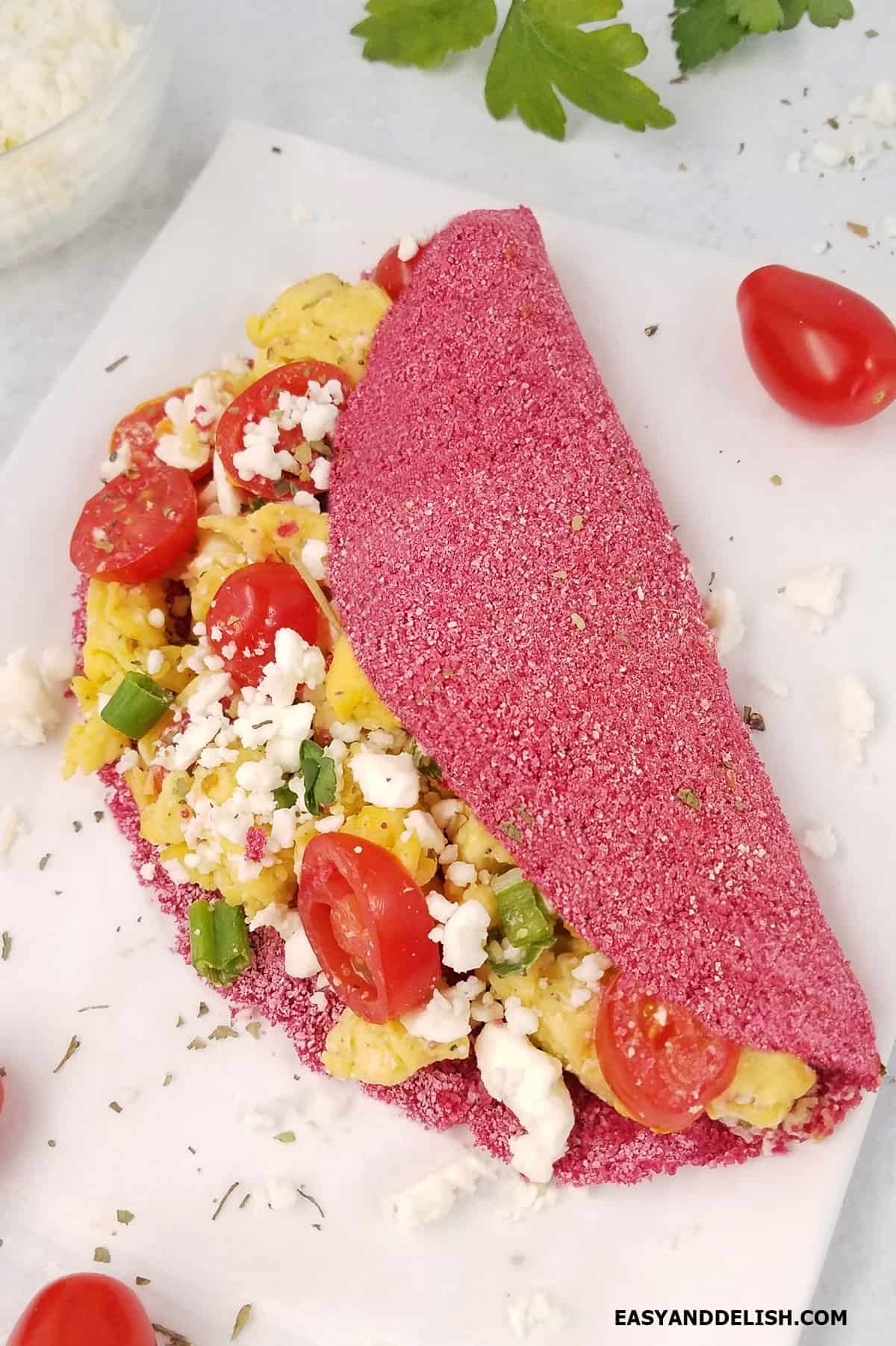
Sweet fillings
- Peanut butter and sliced bananas with a drizzle of honey and some chopped nuts
- Nutella and sliced or chopped strawberries
NOTE: Whatever filling you go for, make sure it isn't too wet; otherwise, it will make your tapioca crepes break apart. To prevent that, I place a bed of mixed greens or fresh baby spinach under my chicken or tuna salad when filling my Brazilian tapioca.
Brazilian Tapioca Recipe
To make Brazilian tapioca crepes you'll simply need tapioca flour, water (coffee or juice), and salt. Then, follow our tapioca recipe from a Brazilian native.
It's gluten-free, dairy-free, vegan, and paleo. You can prepare it in about 10 minutes and cook it in a few seconds.
You can serve them with coffee, tea, soda, milk tea with brown sugar boba, and more.
If you love crepes, you'll be delighted to try these naturally gluten-free, vegan, paleo tapioca crepes.
You can make them with water, resulting in a white tapioca crepe (the most common type). Or, you can make them with juice, like we did, rendering colorful tapioca crepes.
Moreover, you can fill them with melted cheese, scrambled eggs, shredded beef with sauteed onions, chicken or tuna salad, etc.
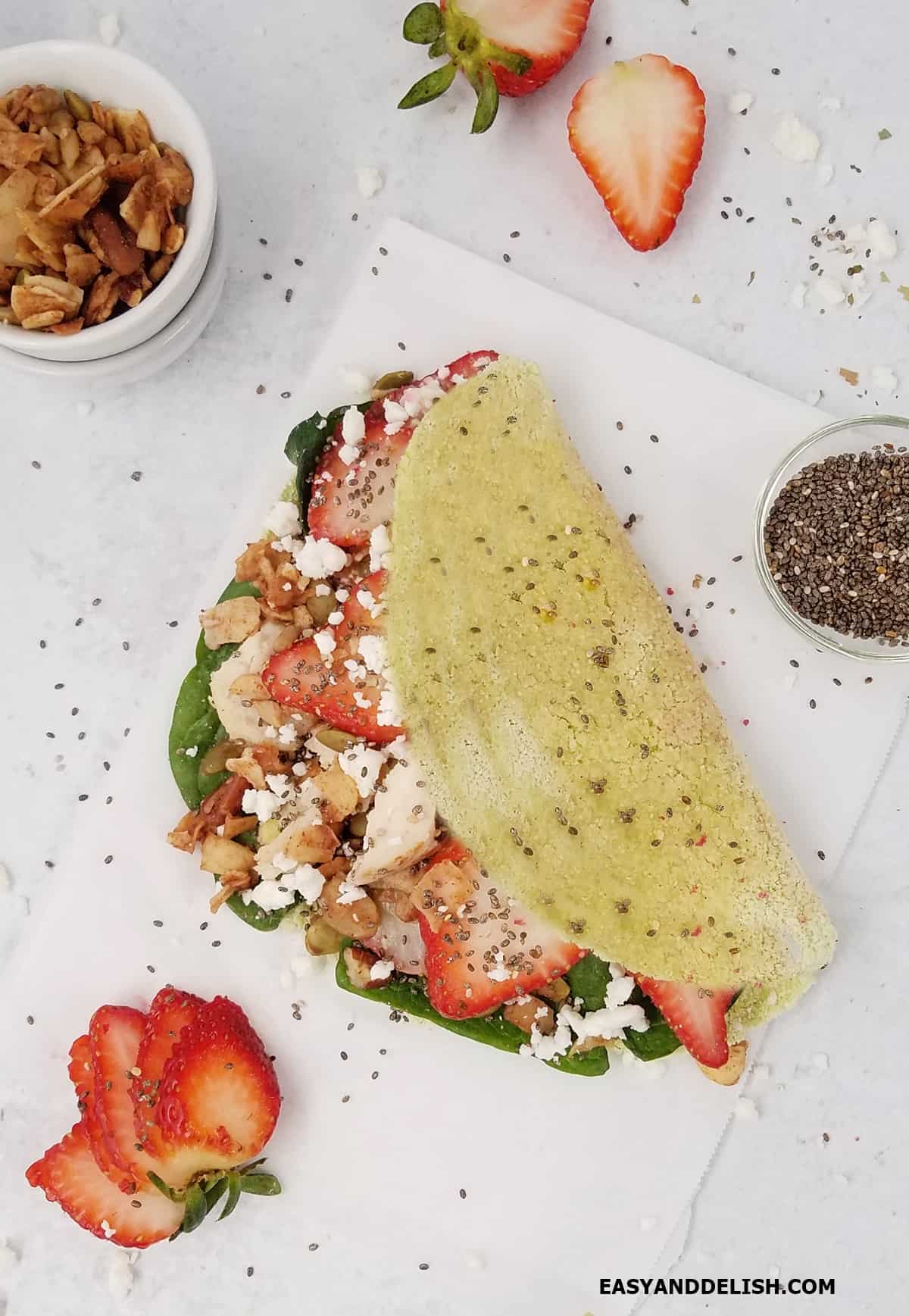
Pro Tips for Making Tapioca Crepes
- Make sure to mix in just enough liquid (water or vegetable juice) with the tapioca flour to obtain a fairly moist yet well-set dough that can crumble easily. Test the correct consistency by placing a spoonful of the mixture in one of your hands and pressing it tightly to form a dough cylinder or ball.
- Cook the Brazilian tapioca crepes in a nonstick skillet; otherwise, the moistened dough will stick to the bottom of the pan.
- Preheat the skillet over medium-high heat before start cooking your Brazilian crepes. Then, reduce the heat to medium when cooking them.
- Use a metal spatula with thin edges to flip the Brazilian crepes.
- Use a fine-mesh strainer to strain the tapioca flour mixture in such a way that when it falls into the hot skillet from the sieve it will form a uniform circle.
- Let the heat bind and glue the grains so that the tapioca starch solidifies and forms a crepe/tortilla (pay close attention, because the crepe/tortilla will be ready in 15-30 seconds).
- Make sure that the edges have as much starch as the center- that way, the edges will not be prone to breakage.
- Before making another tapioca wrap, remove the skillet from heat and wipe both the bottom and sides of the skillet clean with a crumpled paper towel so that the next tapioca won't be browned by the singed leftover grains of starch.
FAQs
I am from Pernambuco state in the Northeastern region, where tapioca is a traditional dish that we make with tapioca flour. It is not a pudding, it is a gluten-free crepe that we often serve at breakfast time either with butter or filled with cheese, or with a variety of savory or sweet fillings at afternoon snack time.
Mostly yes! It's a great cheap source of carbohydrates and therefore, energy, containing a few vitamins and minerals, like iron and potassium, and no fat. Most people may consume it in moderation. Because it is high-glycemic, it may not be suitable for those with diabetes.
Traditional Brazilian tapioca crepes call for a mixture of tapioca flour, water, and salt. However, modern versions use strained fresh vegetable juice (e.g. carrots, beets, or kale) instead to color the tapioca flour.
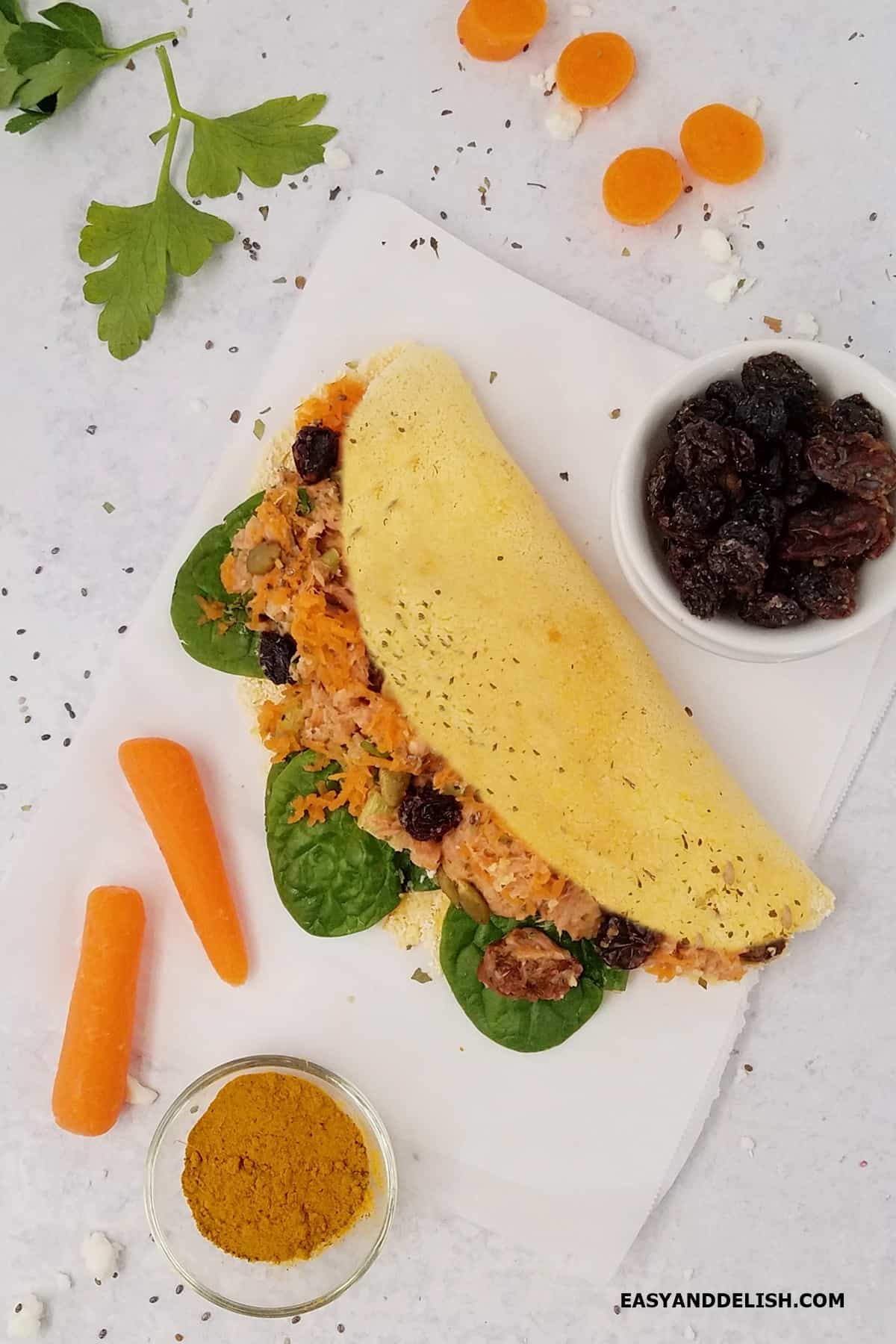
How to Store
- Brazilian tapioca crepes are better eaten right away. Otherwise, they will harden after cooling.
- After cooling, store non-filled tapioca crepes in sealable plastic bags (with air removed as much as possible) or in an airtight container at room temperature for up to 24 hours. You may use them as canapés (called beiju). But be aware they won’t be soft like when they were first made. I am not a fan of beiju (hardened tapiocas) but you can try them and form your own opinion.
Other Brazilian Tapioca Recipes
Besides this Brazilian tapioca recipe, check out these other recipes with tapioca flour:
- Tapioca cake
- Brazilian tapioca pudding
- Farofa recipe
- Gluten-free waffles
- Gluten-free breadsticks
- Brazilian cheese bread
- Cheese rolls
- Bacon and cheese hot pockets
PIN AND ENJOY!
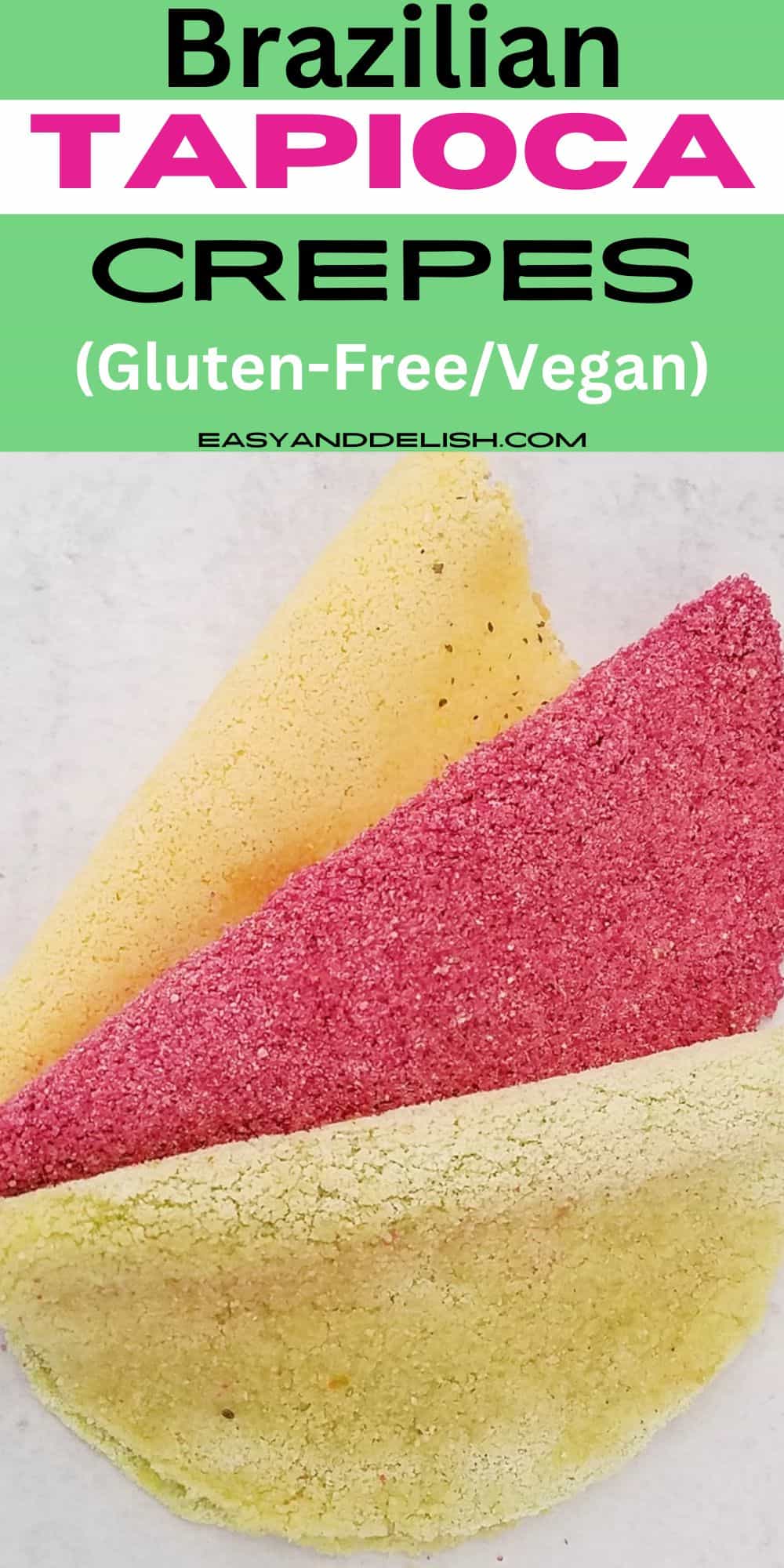
Brazilian Tapioca Crepes (3 Colors)
Equipment
- 1 small nostick skillet
- 1 metal spatula with thin edges
- 1 Medium mixing bowl
- 1 blender ONLY if coloring the tapioca crepes with juice
Ingredients
For the Vegetable Juice
- ¾ cup water if you prefer to make your tapioca crepe white, use water only and skip making any vegetable juice.
- 1 cup baby spinach fully packed -- chopped kale (for the GREEN crepes). Or, peeled chopped beets (pink tapioca crepes) or baby carrots (yellow crepes). For making brown crepes, use prepared black coffee (liquid), unsweetened.
- A pinch of ground turmeric optional (only if using carrots)
For the Tapioca Crepes
- ½ cup tapioca flour If using pre-hydrated tapioca flour, you'll need less juice, about 1 to 1 ½ tablespoons, to color your crepes. Alternatively, you can swap tapioca flour with sour starch, or polvilho azedo, a by-product of the cassava root
- A pinch of table salt
Instructions
- Prepare the juice to color the tapioca crepes: In a blender, blend one of the vegetables (spinach, beets, or carrots) with water until smooth. Using a fine-mesh sieve, strain the liquid and discard the pulp (or use it to make something else). Reserve the strained juice. NOTE: If you prefer to prepare the most common type of tapioca which is white, simply use water instead of juice. The vegetable juices won't flavor the crepes. They only color the tapioca flour with natural food coloring.
- Prepare the tapioca crepes: Add the tapioca flour to a medium bowl. Then, combine a pinch of salt and 3 tablespoons of the strained juice, mixing them well with your fingers until homogeneous and moistened but not to the point of forming a uniform liquid slurry.
- Place a spoonful of the tapioca mixture in one of your hands and press it tightly. If it forms a fairly moist yet well-set dough that can crumble when placed back into the bowl, the consistency is correct. TIP: However, if it gets too soft or liquid like a slurry, stir in a little bit of the tapioca flour. If too dry, combine just a little bit more of the juice.
- Sieve the tapioca flour mixture and cook: Heat a small (5-½ inch diameter) non-stick skillet over medium-high heat for about 1-2 minutes or until hot. Place the wet tapioca flour in a medium sieve. Use one hand to hold the sieve over the skillet and the other to press/rub the starch through the sieve into the skillet.
- Sieve the starch in such a way that when it falls into the pan from the sieve it will form a uniform circle. Reduce the heat to medium.
- Let the heat bind and glue the grains so that the starch solidifies and forms a crepe/tortilla (pay close attention, because the crepe/tortilla will be ready in 15-30 seconds).
- Make sure that the edges have as much starch as the center- that way, the edges will not be prone to breakage. Flip the tapioca over using a metal spatula with thin edges and cook very briefly on the other side, or simply slide the tapioca crepe onto a plate.
- Fill the Brazilian crepes: Place on a plate, spread butter on one of the sides of the tapioca crepe, and fill with any filling of your choice such as chicken or tuna salad (with less mayo), scrambled eggs, melted cheese, shredded meats, Nutella with sliced strawberries, or peanut butter with sliced bananas, etc. TIP: If the filling is too wet, it will make the crepe break apart.
- If filling with shredded mozzarella cheese, place the tapioca crepe on a plate, spread butter on both sides, fill with shredded cheese, roll the tapioca crepes up (like an enchilada), or simply fold it like a taco, return to the skillet over medium heat, and let the cheese melt. Remove from heat and serve immediately.
- NOTE: Between making one tapioca crepe and the next, please remove the skillet from heat and wipe both the bottom and sides of the skillet clean with a wad of paper towels (being careful to not burn yourself), so that the next tapioca won't be browned by the singed leftover grains of starch.
- MEAL PREP AHEAD TIP: Store any leftover juice for later use in a Mason jar for up to 3-4 days in the fridge. Or, mix each juice with enough tapioca flour and store each in a separate airtight container in the fridge for up to 7 days.
Recipe Video
Recipe Notes
- Polvilho Azedo/ Sour Starch/ Almidón Agrio (alternative tapioca starch) is available at local Latin Markets, Brazilian Stores, and online. It is naturally gluten-free.
- Brazilian tapioca crepes are better eaten right away. Otherwise, they will harden after cooling.
- Once cooled, the non-filled tapioca crepes may be stored in sealable plastic bags (with air removed as much as possible) or in an airtight container at room temperature for up to one day. You may use them as canapés (called beiju). But be aware they won’t be soft like when they were first made. I am not fond of beiju (hardened tapiocas) but you are welcome to form your own opinion.
- Make sure to mix in just enough liquid (water or vegetable juice) with the tapioca flour to obtain a fairly moist yet well-set dough that can crumble easily. Test the correct consistency by placing a spoonful of the mixture in one of your hands and pressing it tightly to form a dough cylinder or ball.
- Cook the Brazilian tapioca crepes in a nonstick skillet; otherwise, the moistened dough will stick to the bottom of the pan.
- Preheat the skillet over medium-high heat before start cooking your Brazilian crepes. Then, reduce the heat to medium when cooking them.
- Use a metal spatula with thin edges to flip the Brazilian crepes.
- Use a fine-mesh strainer to strain the tapioca flour mixture in such a way that when it falls into the hot skillet from the sieve it will form a uniform circle.
- Let the heat bind and glue the grains so that the tapioca starch solidifies and forms a crepe/tortilla (pay close attention, because the crepe/tortilla will be ready in 15-30 seconds).
- Make sure that the edges have as much starch as the center- that way, the edges will not be prone to breakage.
- Before making another tapioca wrap, remove the skillet from heat and wipe both the bottom and sides of the skillet clean with a crumpled paper towel so that the next tapioca won't be browned by the singed leftover grains of starch.
- Tuna salad
- Chicken salad
- Melted cheese (use any melting cheese such as mozzarella, cheddar, Pepper Jack, etc)
- Scrambled eggs
- Dulce de leche spread or peanut butter with sliced bananas, a drizzle of honey, and some chopped nuts
- Nutella and sliced or chopped strawberries
** Nutrition labels on easyanddelish.com are for educational purposes only. This info is provided as a courtesy and is only an estimate, since the nutrition content of recipes can vary based on ingredient brand or source, portion sizes, recipe changes/variations, and other factors. We suggest making your own calculations using your preferred calculator, based on which ingredients you use, or consulting with a registered dietitian to determine nutritional values more precisely.
Please note that health-focused and diet information provided on easyanddelish.com is for educational purposes and does not constitute medical advice, nor is it intended to diagnose, treat, cure, or prevent disease. Consult with your doctor or other qualified health professional prior to initiating any significant change in your diet or exercise regimen, or for any other issue necessitating medical advice.
This post was first published on May 2, 2013.
Brazilian Breakfast
I can't talk about Brazilian tapioca without describing Breakfast in Brazil, the meal that features tapioca crepes more often.
I will start by saying that breakfast is served only once per day, usually between 6 and 8 am.
Practically speaking, in Brazil there is no such thing as brunch.
Most of the time Brazilians eat breakfast at home, or sometimes have a light breakfast at the padaria (bakery) on the weekends.
Since the majority of restaurants there serve only lunch and/or dinner, up until recently there was no such thing as going out for breakfast.
But what if we are traveling within Brazil, what do we do about breakfast then? No problem!
Hotels normally serve a plentiful breakfast, which is included in the hotel fee though.
I can guarantee that neither you nor I will go hungry down there. 🙂
Brazilian breakfasts also tend to be on the lighter side, since lunch is our main meal.
So, if you are staying at someone's house in Brazil, generally do not expect to see pancakes or waffles.
In addition, there won't be cooked meats such as bacon and sausage, hash browns, or omelette on your plate...
Well, not even a variety of cereals.
In general, traditional Brazilian breakfast includes the following:
- a small loaf of French bread or toast,
- butter,
- scrambled, hard-boiled eggs, or sunny-side up eggs.
- fruit (usually papaya),
- a cup of black coffee with or without milk, or a glass of juice (orange juice being the most popular),
- Sometimes hot cocoa or fruit smoothies (papaya, banana, or avocado smoothie).
There may also be oatmeal (papa de aveia), yogurt, jams, and sliced or spreadable cheeses, including a mildly salty, silky-textured, spreadable cheese sold in glass jars and eaten on bread called requeijão or Brazilian cream cheese.

Further, you may encounter cold cuts (deli ham, smoked turkey, or salami) and coffee cakes such as orange, plain Brazilian carrot cake without topping, or cornmeal cake (bolo de fubá).
Cereal is not quite as popular, but some Brazilians do like granola.
In hotels, depending on how many stars they have, the options can be endless.
Many items typical of an American breakfast are available there, and/or several regional dishes.
The wide selection of fruit available at the breakfast stations of high-end hotels impresses tourists and has to be experienced.
In padarias (bakeries), the most popular items are café pingado (a cup of coffee with a touch of milk) and pão na chapa (half loaves of French bread toasted with butter on a hot griddle) though.
You may also find misto quente (grilled ham-and-cheese-sandwich).
But that is not all!
Since Brazil is such a large country and has many different regional cuisines, depending on the region or even the state, the breakfast menu may include:
- Some local delicacies such as corn couscous (cuscuz de milho), boiled cassava or inhame (true yam),
- Pão de queijo
- Milk curd (coalhada),
- Mate tea (chá mate),
- Chipas (a cousin ofpão de queijo)
- Biscoito de nata recipe, German coffee cakes such as this apple crumb cake (cuca de maçã) and others, and of course, Brazilian tapioca crepes with butter or filled with cheese.



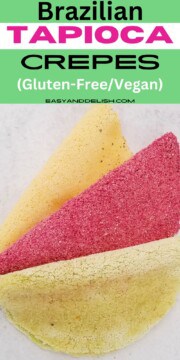
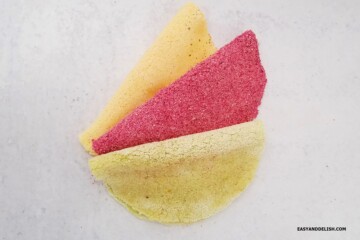
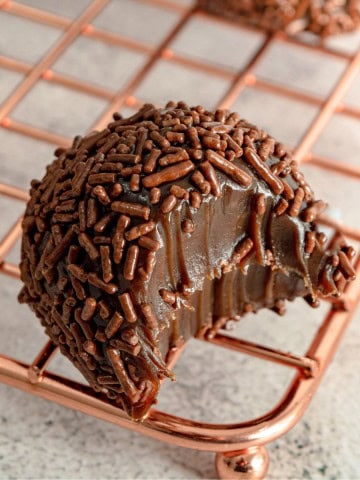


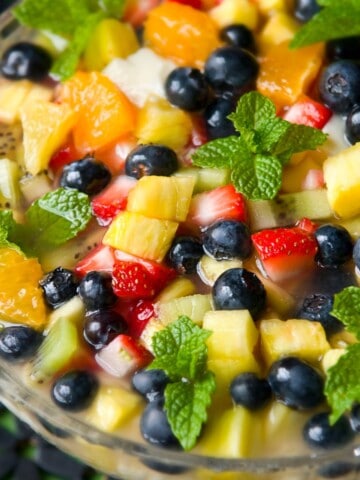
Mosel says
My tapiocas keep getting hard when I make them, am I just over cooking them?
Denise Browning says
Hi, Mosel!
Tapioca crepe , just like risotto, is one of those dishes that you have to eat immediately. If you make tapiocas and store in a sealed jar, they will become hard and transform to what we call beiju (similar to a hard taco). I am one of those people that dislike beiju.
If you follow the process (and measurements) they will be right and soft but please eat them immediately or they will become hard.
As soon as the tapioca is formed and you can flip it to cook the other side for a few seconds (3-5 seconds), remove them from the skillet, spread butter while it still hot, and serve. Or follow the process described with cheese. As you see, you cannot cook them for a long time.
Lee Trotman says
At this moment I am ready to do my breakfast, after having my
breakfast coming again to read further news.
Aninha says
Denaaaaaa!!!! Que maravilha de post!!! Amei! Digna de ser matéria para aula de cultura brasileira para estrangeiros.
Deus te deu dons maravilhosos: cozinhar e falar sobre comida! Deu fomeeeee!!! kkkkk
Denise Browning says
Oh, Ninha...Obg, amiga!!!! Fico feliz que você gostou do texto e que as fotos te deram fome. 🙂 Saudades. Bjs.
Fernanda Price says
Ola tudo bem ? Moro nos Estados Unidos e aqui em cape Cod e bem dificil encontrar as coisas boas no brazuilian market, vc acha que da pra fazer a tapioca com a Red Mill tapioca Flour ?
Obrigada e adorei seu site/blog ! beijos
Denise Browning says
Fernanda:
Obrigada! Fico contente que você haja gostado do meu blog. Seja bem-vinda! Espero que você nos visite mais vezes.
Eu nunca usei a tapioca flour do Bob Red Mill assim que não saberia dizer se funciona ou não. A farinha de tapioca que uso é o polvilho azedo ou sour starch, o qual poderá ser encontrado online em Amazon.com: https://www.amazon.com/dp/B005CBRPIW .
Tanto o gosto quanto a textura é diferente da do polvilho doce ou tapioca starch. Se você chegar a fazer a tapioca nordestina usando a farinha do Bob Red Mill e der certo, por favor me avisa. Um abraço!
Maria` says
oi Fernanda, a tapioca Flour é semelhante a algum polvilho ou a farinha de tapioca nordestina?
obrigada
Denise Browning says
Não sei se essa pergunta é pra mim ou não mas vou responder. A tapioca flour é o nosso polvilho doce usado pra fazer bolos. Já o sour starch é a farinha de tapioca ou goma para tapioca nordestina, a qual apresenta uma textura mais grossa.
Patricia Azevedo Gallagher says
oi denise... depois de alguns anos morando aqui nos usa, sentia muita saudade da nossa tapioca,sou nordestina!! Encontrei nos supermercados daui na marca Bob Red Mill, tapioca flour. Eh uma delicia!!!
Denise Browning says
Olá, Patricia! Que bom receber a sua visita. Fico contente que você haja encontrado facilmente uma marca que você gosta.
Nas minhas tapiocas, eu sempre uso polvilho azedo ao invés de polvilho doce (tapioca flour) pois o gosto é mais similar ao da verdadeira tapioca. A marca que uso, Yoki, pode ser facilmente encontrada online em Amazon.com e também em supermercados latinos. Tenha um bom fim de semana e volta sempre. Um abraço!!!
Raymund says
Looks like the Brazillian way of breakfast is similar in the Philippines, we also do take it at home with some tropical fruits and coffee without milk. This tapioca breakfast of yours looks amazingly delicious, just look at that melting cheese.
Liz says
Oh, my. I could eat a Brazilian breakfast 3 times a day! And these crepes would definitely be on my menu...love that gooey cheese!!!
Pooja says
Hi Its nice to see your blog. Brazilian breakfast looks amazing, papaya in breakfast im new to braz tradition
and I want to say one thing your food photography looks amazing
Denise Browning says
Thanks a lot Pooja! I am glad that you like my blog and food photography. I hope you can visit it again. Wishing you a great weekend!
Kate@Diethood says
I could definitely go for this deliciousness!! Brazil, here I come! 😀
Julia | JuliasAlbum.com says
Beautiful breakfast! Love that serving papaya fruit is traditional for Brazilian breakfast - I love papaya! Thank you for the crepe recipe - I make quite a lot of crepes myself, but regular ones, not with tapioca. Tapioca crepes texture looks very interesting!
Deb says
I enjoyed learning about Brazilian breakfast customs! And the Tapioca Crepes are just delightful!
Abbe@This is How I Cook says
Denise, with fruit like that I'd be veru happy. And what an interesting crepe. I once did a Middle Eastern cheesecake that used honey and cheese as the filling. It was very good so I imagine this is alsoy
Nami | Just One Cookbook says
I don't know why but I think and believe that I had these tapioca crepes before. I try to think where and which occasion I had a chance to eat this (as I don't know how to make) but when you show step by step, I feel like I've seen it before... sometime quite a long time ago... I remember it was delicious. I just don't know when and where I actually had that! Nice to have a recipe now. Such a perfect breakfast display. I want to wake up in the morning to that spread... 🙂
Denise Browning says
Thanks, Nami! It may exist more than one culture that makes these crepes but so far I just know about the Brazilian one. It is a very typical dish from Northeastern Brazil.
Coffee and Crumpets says
I think it's only in America that we find pancakes, waffles, doughnuts...all things sweet! Indian breakfasts are mainly savoury too with a bit of sweet to balance. English breakfasts are always savoury too with just jam being a bit sweet. I always crave savoury stuff for breakfast myself, mainly croissants or French bread.
I am fascinated by your tapioca creeps, bu I have to ask, do they taste sour? Or is it like a sourdough taste? I am trying to imagine it, especially tapioca in sour form!
Nazneen
Denise Browning says
Nazneen: Although its starch is called sour starch is not really sour. The taste is quite mild. They call sour starch for 2 reasons: First, it is because this starch has undergone to a fermentation process; Second, it is to distinguish from another tapioca starch that have not undergone to the fermentation process. Don't worry! These tapioca crepes are pretty mild and gets the taste from the butter and melted cheese.
Mi Vida en un Dulce says
Ohhhh...I want to wake up at your home to have this fantastic breakfast...!!!
Elizabeth says
Que legal! Eu adoro beiju!!!
Denise Browning says
Oi, Elizabeth! Pois então, essa é a oportunidade de fazer beiju ou tapioca... 🙂
Roseli says
WOW! What a delicious breakfast! I love it!!!
Denise Browning says
Thanks, Roseli! I am so glad that you are visiting me here.
Lail | With A Spin says
Denise - I love learning about different cultures and the Brazilian breakfast rituals sound a lot like Bangladesh. Thank you for sharing, my friend.
You know crepe is my all time favorite, right? I can have them for breakfast, lunch and then for dinner again.
Denise Browning says
Thanks, Lail! How interesting...I had no idea that Bangladeshi breakfast habits were similar to ours. Love it!
SallyBR says
ai, Denise! Que maravilha de post! Sabe que eu e meu maridao fomos ao Nordeste uma unica vez - Recife. O cafe' da manha do hotel tinha essa exata tapioca com queijo e eu nunca tinha comido, paulistana que sou...
acho que vou tentar fazer, eu tenho polvilho azedo que comprei numa das idas ao patropi
tenho um pouco de medo de nao acertar a mao na fritura e acabar com uma messy story in my hands... mas estou tentada a faze-lo para uma surpresa um domingo qualquer em casa...
adorei esse post!
beijao!
Denise Browning says
Oi, Sally! Fiquei super feliz com a sua visita!!! Não tenha medo não. É fácil de fazer sim. Leia toda a receita antes de fazer e siga passo-passo que dará certo. Você verá que é tão fácil e simples de fazer que vez por outra ficará tentada a comer essa delícia do meu nordeste. Meu marido americano e filha mais nova adoram tapioca. Vez por outra tenho que fazer aqui em casa e matar as saudades. Se tiver qualquer dúvida é só perguntar! Um abraço.
The Café Sucre Farine says
Oh Denise, this is all so interesting! I love to hear about the customs of other countries. We tend to thing everyone lives like us but that is definitely not true. These tapioca crepes sound wonderful and you photos are so pretty!
Denise Browning says
Thanks a lot, Chris! You are always so nice...Yes, customs are something that vary from country to country definitely.